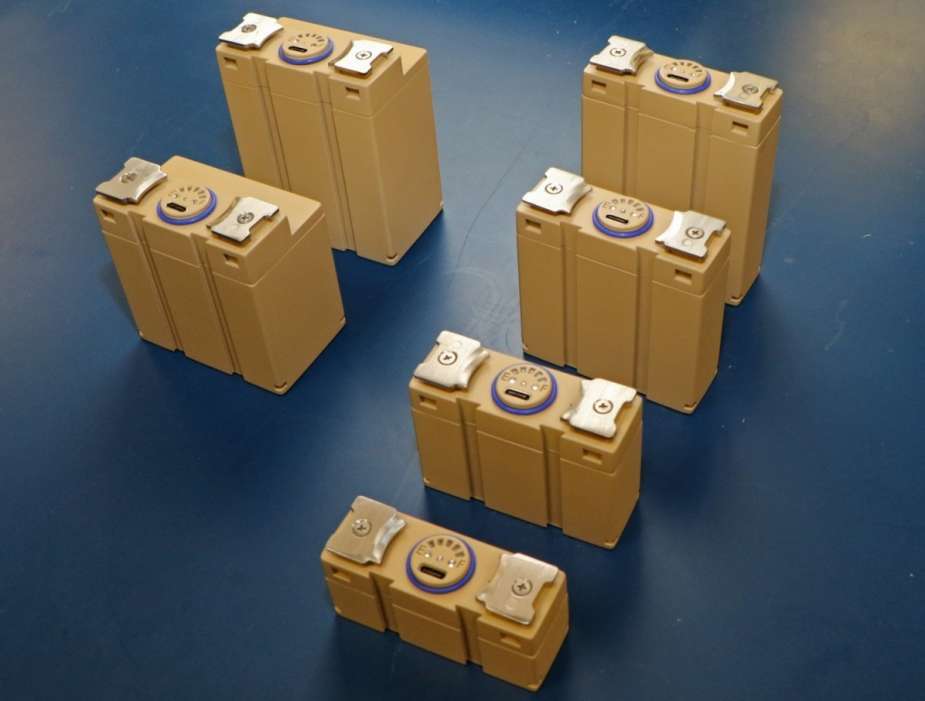US Army modernizes tactical batteries to strenghten industrial supply chain
U.S. Army researchers are advancing the capabilities of tactical batteries as a critical piece of the military’s comprehensive effort to improve U.S.-based manufacturing and strengthen the industrial supply chain. Dan Lafontaine, DEVCOM C5ISR Center Public Affairs, explains.
Follow Army Recognition on Google News at this link

U.S. Army C5ISR Center enlisted adviser Sgt. Corey Burrell demonstrates a Small Tactical Universal Battery integrated into a Powered Weapon Demonstrator at Aberdeen Proving Ground, Maryland, on June 3, 2021 (Picture source: U.S. Army/Dan Lafontaine)
Engineers at the U.S. Army’s Command, Control, Communications, Computers, Cyber, Intelligence, Surveillance and Reconnaissance (C5ISR) Center are focused on integrating advanced cell chemistry into batteries as the next generation of modernized Soldier electronics are fielded. The team is focused on developing standardized form factors for use in Soldier-worn and handheld equipment such as radios, GPS, night-vision devices, and weapons. “By standardizing battery form factors, the Department of Defense aims to aggregate demand throughout the services and improve buying power among the industry’s battery cell manufacturers,” said Dr. Ashley Ruth, a C5ISR Center research chemical engineer. In addition, standardization avoids the old model of fielding a proprietary battery for each piece of gear, as technology developers have historically delivered unique batteries for new capabilities. The Center is an element of the Army Combat Capabilities Development Command, known as DEVCOM.
“The Army is working on forecasting a fully developed demand signal for a range of Soldier batteries,” said Dr. Nathan Sharpes, a research mechanical engineer with the Center. “This provides an incentive for industry to onshore battery manufacturing to the United States and support the domestic industrial base and secure the supply chain. The overall DoD goal is the ability to procure cutting-edge batteries affordably and reliably with a coordinated strategy.”
The C5ISR Center’s latest R&D effort in support of battery standardization is the Operational Single Cell for Accessory Readiness, or OSCAR. The program’s benefits include safety, performance, and cost, according to Sharpes. OSCAR research originated from the need to develop a AA form-factor military battery capable of recharging.
New electronics in the Army’s R&D pipeline can require higher instantaneous power draw than current AA form-factor batteries can provide, according to Sharpes. OSCAR will be capable of performing like a AA battery in legacy applications but also enter a high-power mode to satisfy next-generation enabler devices such as night-vision scopes that are typically mounted to a rifle or helmet.
With the capability for recharging more than 100 times, OSCAR batteries represent significant cost savings compared with existing single-use options. The C5ISR Center anticipates prototypes available for lab and safety testing in the near future.
OSCAR follows the team’s successful development of the Small Tactical Universal Battery, or STUB, which is a standard family of batteries for handheld and small form factor devices, with eight sizes that share a common mechanical and electrical interface — the key to unlocking interoperability, Sharpes said. Each battery size provides a different amount of energy, from which Soldiers could choose, depending on their mission needs. This interoperable battery system seamlessly delivers the correct voltage and power level needs to any device.
Army project managers can now procure these batteries for integration into fielded Soldier-worn and handheld systems. The STUB program’s current emphasis is to mature manufacturing to ensure the Army has sufficient and consistent demand for industrial production.
These C5ISR Center’s research projects support the broader effort within the Defense Innovation Unit’s Family of Advanced Standard Batteries program, along with DEVCOM’s Ground Vehicle Systems Center and the Navy.
The C5ISR Center
The C5ISR Center is the Army’s applied research and advanced technology development center for C5ISR capabilities. As the Army’s primary integrator of C5ISR technologies and systems, the center develops and matures capabilities that support all six Army modernization priorities, enabling information dominance and tactical overmatch for the joint warfighter.
The C5ISR Center is an element of the U.S. Army Combat Capabilities Development Command. Through collaboration across the command’s core technical competencies, DEVCOM leads in the discovery, development and delivery of the technology-based capabilities required to make Soldiers more lethal to win our nation’s wars and come home safely. DEVCOM is a major subordinate command of the U.S. Army Futures Command.

Different versions of the Small Tactical Universal Battery (Picture source: U.S. Army/Dan Lafontaine)
Defense News August 2023


























